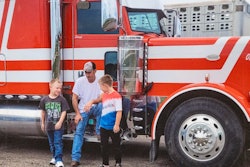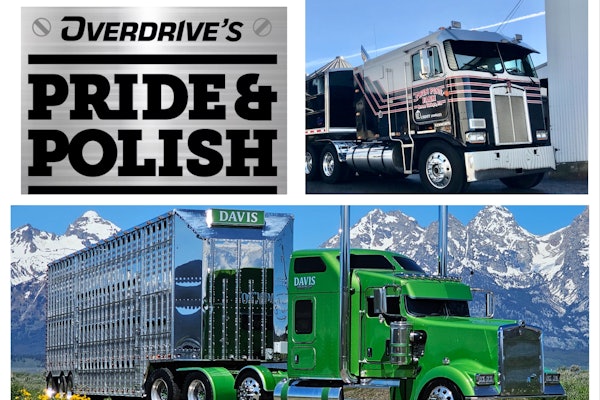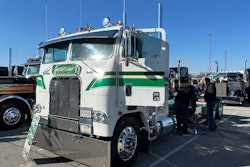Trucking news and briefs for Friday, July 12, 2024:
Cargo theft activity in Q2 higher than 2023, down from Q1
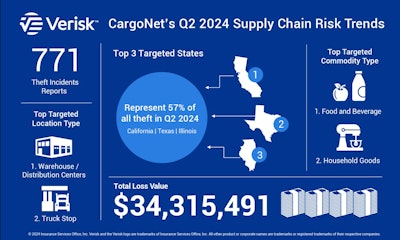 CargoNet recorded 771 theft incidents in the second quarter this year, representing a 33% increase compared to the second quarter of 2023. However, theft activity decreased 10% from all-time highs established in the first quarter of 2024.CargoNet, a Verisk company
CargoNet recorded 771 theft incidents in the second quarter this year, representing a 33% increase compared to the second quarter of 2023. However, theft activity decreased 10% from all-time highs established in the first quarter of 2024.CargoNet, a Verisk company
Cargo theft recording firm CargoNet has revealed cargo theft in the second quarter of 2024 increased significantly over the same period a year ago, but fell from first-quarter highs.
CargoNet's analyst team noted slight behavioral shifts in the country's most prolific organized cargo theft groups operating in Southern California. Across the board, these groups evolved to be more discriminating in their shipment targets, stealing high-value freight like motor oil and computer electronics less frequently.
[Related: 'Iluminati' hack hits DAT boards with thousands of $20/mile postings]
Compared to the first quarter of 2024, CargoNet observed significant growth in targeting of vitamins and supplements, alcoholic beverages (primarily liquor), and over-the-counter skincare products. In contrast, theft of vehicle accessories like tires and motor oils, footwear, and consumer electronics such as televisions and computers decreased notably.
Theft activity was highest in California, Texas, and Illinois. In line with the 10% decrease in activity from Q1, reported activity in the top five counties -- Los Angeles County, California; San Bernardino County, California; Riverside County, California; Cook County, Illinois; and Dallas County, Texas -- shrank significantly. However, in most areas, activity remained relatively consistent. For example, while activity in Dallas County decreased, activity in Tarrant County grew significantly due to a surge of thefts around the western edges of Fort Worth.
CargoNet expects cargo theft activity in the third quarter of 2024 to remain elevated. Organized cargo theft rings in Southern California continue to be the most prolific threat, but theft by deception schemes are growing in popularity across the continental United States, particularly targeted pilferage schemes and non-delivery of whole shipments. The firm anticipates that these methods of cargo theft will continue to increase in popularity.
[Related: Southeastern cargo theft ring busted]
Truck caught 100k pounds overweight in Connecticut
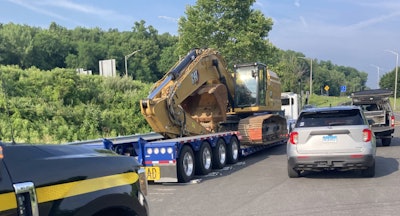 Connecticut State Police recently encountered a truck operating at more than 100,000 pounds overweight without Connecticut permits.Connecticut State Police
Connecticut State Police recently encountered a truck operating at more than 100,000 pounds overweight without Connecticut permits.Connecticut State Police
A New York-based trucking company took “oversize” to the next level in Connecticut when one of its trucks was found to be operating at more than 100,000 overweight.
On July 10 around 7 a.m., Connecticut State Police troopers were conducting commercial vehicle enforcement on I-84 in the Danbury area when an oversize load was seen bypassing the Danbury scale along I-84 EB by traveling the secondary roads in the area.
The truck was pulled over, and an on-scene investigation found the truck had numerous oversize load permit violations. Additional checks found the truck out of New York did not have a Connecticut DOT oversize permit.
Using portable scales, CSP troopers found the truck’s gross weight to be 183,300 pounds -- 103,300 pounds over the legal limit. Additionally, six of the eight axles were not in compliance with the maximum allowed statute weight of 18,000 pounds per axle. Size violations were also found, including over-height, over-length and over-width without a permit.
The unnamed motor carrier was fined $39,101, and the truck was placed out of service.
[Related: Hauling smart with high, wide and sometimes ugly freight]
Cummins receives $75M to expand ‘zero-emissions’ truck production
Cummins Inc. announced Thursday that the company has been awarded $75 million to convert approximately 360,000 sq. ft. of existing manufacturing space at its Columbus (Indiana) Engine Plant (CEP) for zero-emissions components and electric powertrain systems.
The $75 million grant is the largest federal grant ever awarded solely to Cummins and is part of the appropriations related to the Inflation Reduction Act.
Cummins will match the grant and invest $75 million for a total of $150 million to convert the space and expand production of battery packs, powertrain systems and other battery-electric vehicle (BEV) components for Accelera by Cummins, the company’s zero-emissions business segment.
[Related: EPA 2027 diesel emissions regs: How high will truck prices go?]
“This DOE grant is another step forward in the progress we are making toward a zero-emissions future and expanding battery manufacturing in the United States, strengthening our global position in electrified solutions for commercial markets,” said Amy Davis, President of Accelera by Cummins. “Today’s announcement represents a crucial step in advancing electrification and domestic battery supply chains. Partnership with government, customers and the industry as a whole is required to accelerate the shift to zero.”
After the completion of this project, CEP will house approximately 350 employees focused on BEV-related work. Nearly half of the 1.42 million sq. ft. facility, which opened in 1926, will be dedicated to zero-emissions manufacturing. The electric powertrains produced at CEP will result in greenhouse gas emission reductions of approximately 104 million metric tons of carbon dioxide by 2030, the company said.
[Related: Uncovering engine marketshare with fleet activity data]
Driver named Highway Angel for assisting at fatal crash scene
Darrin Gillmore, a Bison Transport driver out of Barrie, Ontario, Canada, has been named a Highway Angel by the Truckload Carriers Association for stopping to help rescue several passengers from a fatal crash.
 Darrin Gillmore
Darrin Gillmore
“I had my student pull over, so I grabbed my fire extinguisher, my bolt cutters and my first aid kit,” said Gillmore. “We went to the accident scene and there was a lady that was fatally injured.”
A man involved in the wreck was out of his vehicle, so Gillmore and Li helped him lay down and get comfortable until EMS arrived. Then the men helped cut the horn on one car and cut the battery to prevent a fire. There was a teenage boy in the accident, who had been traveling with his now-deceased grandmother.
“We tried to keep the kid calm -- obviously he knew his grandma was dead,” Gillmore said.
The men helped him out of his vehicle and tried to keep him calm and assess his injuries. “We comforted him until the EMS showed up, and they took over from there,” he said.
Gillmore has been driving trucks for 20 years and has been at the scene of about three fatalities a year, he estimated.
“I’ve been to many, many, many accidents, and I always stop and I always help -- I just do my best,” he said.

